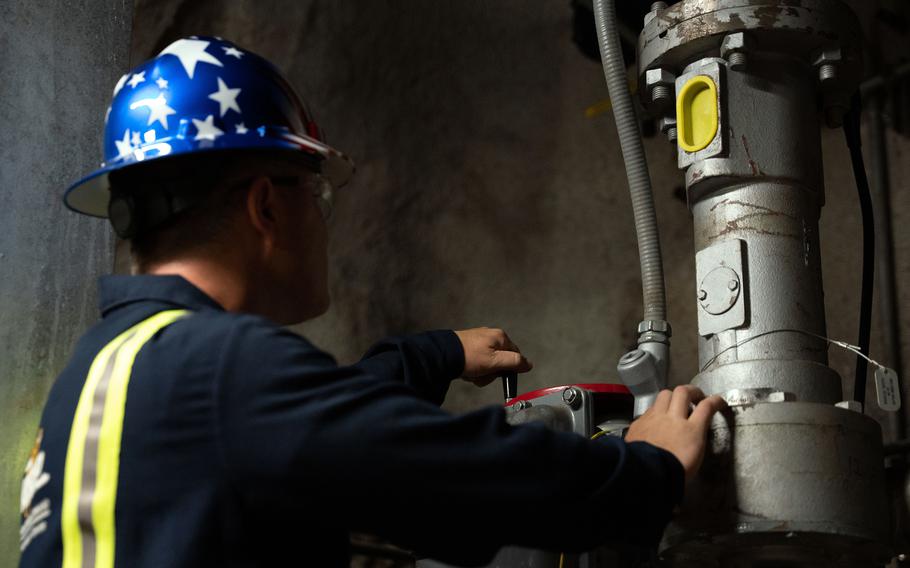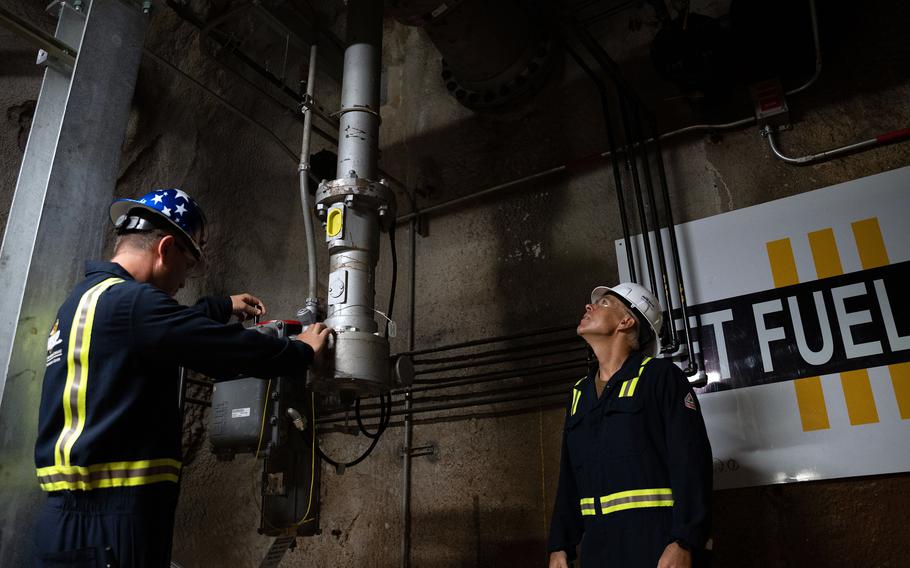
A Navy official inspects fuel gauges and pipes at the Red Hill Bulk Fuel Storage Facility in Halawa, Hawaii, Sept. 5, 2023. (Gabrielle Zagorski/U.S. Marine Corps)
Lawyers for hundreds of people seeking damages from a Navy fuel spill in Hawaii say the federal government “recklessly destroyed” evidence on cellphones belonging to officers in charge of the spill’s response, according to a court filing Tuesday.
Apple iPhones issued to Navy Capts. Erik Spitzer and James Meyer were wiped clean of call logs and text messages before being reissued to their successors at Joint Base Pearl Harbor-Hickam, Hawaii, according to the motion filed in U.S. District Court for Hawaii.
Spitzer, the base commander, and Meyer, the head of Naval Facilities, Hawaii, which includes the base public works department, failed in November 2021 to promptly alert base housing residents that toxic spills at the Red Hill Bulk Fuel Storage Facility, 5 miles northwest of Honolulu, had contaminated their water supply, the plaintiffs’ lawyers allege.
The lawyers — Lyle Hosoda, Kristina Baehr and Frederick Baker — asked for sanctions against the Navy that compensates for the loss of potential cellphone evidence. They argue the court has held that “spoilation,” or destroying evidence, implies that evidence would have undermined the government’s defense.
The court should find that the lost phone data would have shown that the Navy “knew of the water contamination by the afternoon” of Nov. 28, 2021, “but failed to warn” consumers of the danger, the motion for sanctions states.
Jet fuel spilled into the water supply for thousands of military homes in May and November 2021, according to the suit filed by an Army spouse, Patrick Feindt Jr. The suit alleges the contaminated water caused seizures, gastrointestinal disorders, neurological issues, burns, rashes, lesions, thyroid abnormalities, migraines and neurobehavioral challenges.
About 300 people had joined the Feindt lawsuit when another 1,002 complainants filed legal claims in June that may add them to the suit pending in Honolulu.
Hundreds of base residents vacated their homes for temporary lodging in hotels and motels while the Navy dealt with the cleanup.
Meyer, as overseer of the base water system, was required by the Safe Drinking Water Act to issue a “do not drink” notice to all users on the water system, but failed to do so, according to the motion.
Instead, Spitzer on Nov. 29, 2021, a day after complaints started pouring in, allayed concerns with a public message that the water was safe.
“I can tell you at this point that there are no immediate indications that the water is not safe. My staff and I are drinking the water on base this morning, and many of my team live in housing and drink and use the water as well,” Spitzer wrote by email to base water users.

Navy officials inspect fuel gauges and pipes at the Red Hill Bulk Fuel Storage Facility in Halawa, Hawaii, Sept. 5, 2023. ()
By erasing Meyer and Spitzer’s cellphones, the Navy destroyed potentially damaging evidence, the motion alleges.
“The Government must explain why cellphone call and text message evidence from two key leaders of the Red Hill response … was recklessly destroyed …,” the motion states. “It is hard to imagine a more relevant and material item of evidence for Plaintiffs to establish their negligence claims.”
The Navy has declined comment thus far on the suit, citing ongoing litigation. The government had not filed a response in federal court in Hawaii as of Tuesday.
Spitzer retired in June 2022, with a Legion of Merit, and was succeeded by Capt. Mark Sohaney.
In December 2021, Spitzer apologized on the joint base’s Facebook page for his Nov. 29, 2021, message to families affected by the spill.
“If there was one day I had a chance to do over, it would be that day,” he wrote. “The words used in my notification were not the compassionate and validating words I wish were used, and I regret I did not tell our families not to drink the water. I am deeply remorseful. My apologies to you all.”
Also in June 2022, Meyer was succeeded at Hawaii Naval Facilities Engineering Systems Command by Capt. Cameron Geertsema. However, Meyer stayed on to lead the organization responsible for emptying the Red Hill facility, which Defense Secretary Lloyd Austin ordered in March 2022 to be defueled and permanently closed.